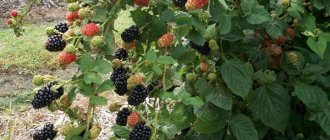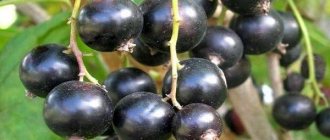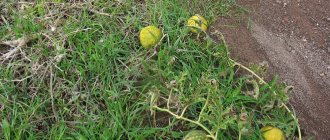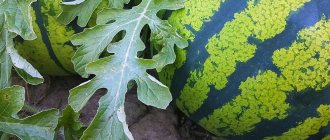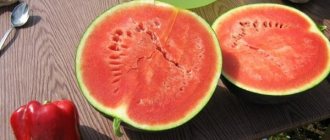Types and varieties of plants, appearance
Watermelon is one of the most favorite berries of many adults and children. This is a large berry, the area where watermelons grow is called melon. There are large and small watermelons, while most watermelons contain dark seeds inside, but there are some that do not have them.
Watermelon has a spherical, oval or flattened shape. Some watermelons have a white or yellow rind without stripes. The most popular type of watermelon is dark green in color with lighter stripes. In nature, there are different varieties and types of watermelons, which differ in appearance and taste. All varieties are usually classified into early, medium ripeness and late ripening.
The list of early ripening varieties includes the following types:
- Victoria;
- Skorik;
- Jenny;
- Lady;
- Stabolite;
- Ogonyok;
- Dolby.
The varieties of watermelon of medium ripeness include the following types:
- Black Prince;
- Couch potato;
- Top Gun;
- Green torpedo;
- Dumara;
- Antey;
- Ataman.
Below are popular and tasty late varieties of watermelons with photos and descriptions that can be grown in a greenhouse or melon patch:
- Spring;
- Icarus;
- Chill;
- Melania.
The era of Astrakhan watermelons
In Russia, watermelons have long been grown in Little Russia, Kuban and the south of the Volga region, where weather conditions allowed large, sweet fruits to ripen. In Soviet times and until now, watermelons from near Astrakhan were especially respected and in demand among buyers. The phrase “Astrakhan watermelon” meant that under the thin rind there would definitely be scarlet, sugary pulp of inimitable sweetness and aroma.
This area was considered the main melon growing area of the Soviet Union, and the main variety on the plantation was the Astrakhan watermelon.
The first harvest of striped, oval-shaped fruits was obtained in 1977, at the Astrakhan Institute of Vegetable and Melon Growing. The watermelons, which ripened 70–80 days after sowing, turned out to be so productive that up to 120 tons of sugar watermelons were harvested per hectare of melons, which, moreover, could be stored for up to 2.5 months and could easily be transported. These circumstances made Astrakhan watermelons the most popular and beloved in the country.
Where and how does it grow
Few people know where and how watermelon grows (see photo selection below). Watermelons are a heat-loving crop that is not suitable for winter climates. For a watermelon to grow big and good, it needs a lot of sunlight. It is for this reason that most watermelons grow in the South.
Watermelons of the type Ataman, Black Prince, Icarus and many others can grow in Namibia, South Africa and other areas of South Africa. You can also find Lady or Green Torpedo watermelons in China, Turkey, Iran, Egypt, Russia, Ukraine and Uzbekistan. For watermelons, steppe and Mediterranean climates are most suitable, where summers are hot and long and winters are short and mild.
Methods for planting watermelons on the site
Depending on the climatic conditions of the region and the availability of free space, watermelons are grown in different ways.
In a bucket
In this way, watermelon can be grown at home. To do this, first seedlings are grown in a small pot. Further work is carried out as follows:
- Prepare a bucket with a volume of 16 liters (a wooden box measuring 50x50x30 cm can be used).
- The container is filled with fertile soil with neutral acidity, mixed with perlite in a ratio of 2:1. This will protect the soil from stagnant water.
- After the third true leaf appears on the seedlings, the plant along with the earthen ball is transplanted into a bucket.
- The optimal daytime temperature is 25–30°C, night temperature is 18–20°C. Such conditions are created in spring and summer on a closed balcony.
- Watering should be moderate; watermelon does not like waterlogging.
- The soil is fertilized every 2 weeks. Liquid fertilizers for vegetables are suitable for this (add 1 tsp of fertilizer to 1 liter of water). Only fresh solution is prepared for irrigation.
- At the stage of ovary formation, a second feeding is carried out with an increased content of potassium and phosphorus, and after 2-3 weeks - a third.
- The side shoots of the watermelon are pinched, leaving only the main shoot.
- During the flowering phase of watermelon, artificial pollination is carried out: male flowers with stamens are picked, the petals are removed and the female flowers (with a thickening at the bottom) are pollinated, touching the pistils with the stamens.
- After fruit set, no more than two berries are left on the plant, the rest are removed.
- Fruits about 10 cm in size are placed in a net and tied to a support.
After about three months, you can harvest a harvest of delicious berries weighing about 1 kg.
According to the author, this method can be considered more of a hobby than a way to obtain tasty berries. In apartment conditions, it is unlikely to provide the plant with optimal temperature conditions, except perhaps on the balcony during the hot summer. A watermelon grown at home is unlikely to delight you with the aroma and sweetness of the pulp. For those who decide to experiment, I advise you to make a drainage hole at the bottom of the container to protect the roots from waterlogging. And to determine whether a watermelon needs watering, it is recommended to slightly lift the bucket with the plant, basing its weight on the soil moisture.
On the trellis
In the southern regions, melon plants are cultivated in open ground, in which case they do not require staking. When grown in northern regions with a cool and humid climate, trellises can be used. This is especially true for small areas where there is little light and moisture stagnation is likely. In such places it is recommended to grow watermelons of small-fruited hybrids and varieties:
- On both sides of the beds, a support at least 1.5 m high is dug in, and ropes or twine are pulled between them.
- Other ropes are tied to the stretched ropes, which go down to the plants and serve as a support for the watermelon stems, determining the direction of growth.
- The end of the lowered rope is secured to the stem of the plant or to the ground.
- The main stem is tied in a vertical direction, the top is not pinched. All side shoots are removed, since female flowers are formed mainly on the main stem.
- The grown fruits are placed in nets, then individually tied to a trellis so that they do not fall under their own weight.
With the formation of 2-3 fruits the size of a chicken egg, the remaining ovaries are removed, since more watermelons will not have time to ripen.
The trellis is relevant for small areas where there is little light and moisture stagnation is likely.
Under covering material
Cultivating watermelons under covering material has now become especially popular. The additional costs of film are offset by the advantages of this technology, including:
- protection of seedlings from weeds in the early stages of growth in open ground;
- reduction of daily temperature fluctuations;
- accumulation and retention of soil moisture.
The use of covering material allows you to shorten the period of fruit ripening by 7–10 days. This method is especially relevant in short or humid summers and can be used in several ways:
- Warm bed under black polyethylene. Beds no more than 10–15 cm high are made at a distance of 1.5 m from each other, a longitudinal ditch about 40 cm deep is dug in the middle, and layers of hay or straw are laid in it. The hay is spilled with water, and the straw with a urea solution (0.5%) to speed up decomposition. To create additional moisture, fresh grass is laid on top of the first layer. Everything is compacted tightly. A layer of humus about 10 cm thick is laid on top and mixed with soil taken from the edges of the furrow. This will help create the nutrient medium for watermelons that is necessary for the first time after planting the seedlings. Everything is spilled with water to a soil depth of 25–30 cm and covered with black polyethylene. Cross-shaped slits are made on the film in a checkerboard pattern at a distance of 0.9 m. The film is pressed along the edges with heavy objects so that the wind does not tear it off. Watermelon seedlings are planted in slots.
- Temporary film shelters. In case of a sudden cold snap, you can install arcs over the garden bed, over which film or other covering material is stretched. The width and height of such a structure should be about 70 cm. This measure will also speed up the ripening of the crop by 10–15 days. In extreme heat, the film is removed so that the watermelons do not overheat in the sun.
In case of a sudden cold snap, you can install arcs over the garden bed on which the covering material is pulled
- The easiest way to cover seedlings: spunbond (non-woven agrofibre) or film is laid along one side of the ridge. This will allow you to quickly cover the plants directly along the vines, protecting them from possible frosts.
Spunbond can be used to cover plants directly along the vines, protecting them from possible frosts.
Benefit
Whatever the variety of watermelon, it is very beneficial for the human body. With its help, you can improve your health and reduce the symptoms of certain diseases. The following beneficial properties of watermelon are highlighted:
- promoting health and improving visual function;
- positive effect on the nervous and immune system;
- lack of feeling of hunger and thirst after eating watermelon;
- improvement of heart function;
- positive effect on the circulatory system;
- improving the functioning of the gastrointestinal tract;
- help for chronic diseases.
Planting pattern and depth
There are different schemes for planting watermelons in open ground, their choice is influenced by:
- cultivation method (watering or without artificial irrigation). Plants grown without watering take up less space, so they can be placed more densely;
- watermelon variety (early or late ripening);
- estimated fetal weight (3–5 kg or more than 8 kg). The higher the planting density of watermelons, the smaller the fruits will grow.
When planting watermelons, take into account that the plants grow widely and should not interfere with each other:
- in the garden bed, early varieties are placed at a distance of 1.4x1.4 m or 1.4x0.7 m;
- watermelons of mid-ripening and late-ripening varieties are planted according to a 2x2 m pattern; 2.1x1.4 m; 2.1x1 m.
The smaller number shows the distance between plants when planting, the larger number - between the rows.
The higher the planting density of watermelons, the smaller the fruits will grow.
The depth of planting seed in open ground can vary from 3 to 8 cm and depends on:
- on their size (the smaller the seed, the shallower the planting depth);
- type of soil (incorporation is deeper on light soils than on heavy soils);
- soil moisture (seeds are placed on a moist layer).
The seedlings are planted a little deeper than when growing in a pot, so that the root collar is not damaged by winds.
Application
In cooking
Various watermelons, photos of which you can see in the selection, are widely used in cooking. It can be consumed in its pure form or prepared in desserts, smoothies, side dishes and exotic snacks for a buffet table. In the summer, you can refresh yourself with fresh watermelon juice or a smoothie.
Particularly skillful housewives roll watermelons into glass jars and pamper themselves and their loved ones with them in the winter. You can make candied fruits from watermelon rinds, and make delicious jelly from the pulp.
In medicine
Watermelon can be used for medicinal purposes for various ailments. Also, such a berry can serve as a preventive measure for many pathologies. Watermelon helps patients with impaired renal function because it has a diuretic effect. It can also be used for disorders of the gastrointestinal tract and inflammation. The components contained in watermelon help regulate intestinal function and improve digestion. With the help of watermelon, you can clean blood vessels and strengthen bones. Watermelon is also indicated for impaired liver function, as it has a choleretic effect.
When losing weight
Watermelon is widely used for weight loss, since it consists of 90% water, while it contains many useful components. It is included in many diets that help a person lose weight. Also, when losing weight, watermelon has a diuretic effect, due to which excess fluid is removed from the body, which interferes with rapid weight loss. Using watermelon liquid, you can remove toxic substances, toxins and other harmful components from the body. The carbohydrates that make up the sweet pulp are quickly broken down in the body and are not stored in adipose tissue.
In cosmetology
Watermelon is useful not only for human internal organs, but also with its help you can improve the condition of your skin and hair. Using watermelon juice, you can improve your complexion, tone and soften your skin. Moreover, watermelon is suitable for both dry and oily skin types. Watermelon seed oil contains linoleic, oleic, stearic and palmitic fatty acids, which improve hair condition. Watermelon notes can also be found in perfumes. The aroma of watermelon invigorates and charges you with a good mood.
Step-by-step instructions for planting a watermelon
In order for the preparation and planting of watermelon seeds to proceed correctly, the following steps should be followed.
Seed selection
This is a crucial period of preparation for sowing watermelon, as it largely determines the success of growing and obtaining fruit. The variety of varieties and hybrids allows you to choose the plant most adapted to the growing conditions in your region. Watermelons can differ among themselves in large or small fruits, the speed of their ripening, and have different resistance to diseases.
Pre-sowing seed preparation
Preparing seeds for sowing is an important stage in the cultivation of vegetable crops, especially in home cultivation, since in conditions of limited space the requirements for plant selection increase.
Calibration
Sorting seeds by size allows you to select the best ones and discard small and damaged ones. Selection is usually carried out manually: seed material is scattered over a smooth surface and divided into large, medium and small. Large seeds, as a rule, contain a large supply of nutrients, which will subsequently provide the plants with good growth and high yield.
The largest seeds are selected for sowing
Warming up and soaking
Warming and soaking increases the rate of biochemical reactions in cells, which improves seed germination, the formation of more female flowers, good growth and development of lashes.
Procedure:
- The seed material is poured into a fabric bag and immersed in warm water (50–60°C) for 2–3 hours.
- Then it is transferred for half an hour for disinfection into a slightly warmed weak solution of potassium permanganate.
- Remove the bag and allow excess moisture to drain.
- The seeds are laid on damp sand, cotton or paper and left in a warm room. They are kept at room temperature for about 2 days until the seedlings appear.
If you bought treated seeds, they cannot be soaked and should be planted directly into the ground.
Germinating watermelon seeds for planting in open ground or for seedlings
Hardening
To increase the resistance of plants to sudden temperature fluctuations and to obtain an earlier and more abundant harvest, seeds are hardened. Most often, seed material is affected in two ways:
- exposure to constant low temperatures. For 1–2 days, the swollen and hatched watermelon seeds are kept in the refrigerator at a temperature of 0±1°C with periodic stirring. Such hardening can also be carried out by burying the seed in a small box or bag in the snow;
- exposure to variable temperature. The swollen seeds are kept in the refrigerator for about 12 hours at a temperature not lower than 6°C, then they should be kept warm for the same period of time at a temperature of 18–20°C. The procedure is repeated three times.
Before sowing, the seeds are slightly dried.
Selection of containers and soil
To avoid further transplanting or picking, the seeds are sown in separate pots or containers with a volume of at least 300 ml (minimum container height - 12 cm, diameter - 10 cm). For planting, prepare a soil mixture into which sand, turf soil and peat are added in equal proportions. Add to 5 liters of prepared soil:
- dolomite flour and potassium sulfate (50 g);
- double superphosphate (100 g);
- ammonium nitrate (50 g).
Seedling containers are filled with the mixture so that about 3 cm remains between the surface of the soil and the edge of the pot. As the plants grow, soil can be added to the pot.
To avoid further transplantation or picking, the seeds are sown in separate pots.
Sowing watermelon seeds
To know how to plant a watermelon correctly depending on climatic conditions, sowing is done through seedlings or directly into open ground.
Sowing seeds for seedlings
The best time for planting is mid to late April. Sprouted seeds with a root of 1–1.5 cm are sown to a depth of 3 cm, 4–5 pieces in each container, sprinkled with earth on top, watered and covered with glass or film. The pots are placed in the brightest window, preferably a southern one.
It is important that there are no drafts in the room.
Sprouted seeds with a root of 1–1.5 cm are sown to a depth of 3 cm, 4–5 pieces in each container.
Planting seeds in open ground
Prepared seeds can be sown directly into open ground only in southern regions with a warm climate. The optimal time for planting is when the air temperature is between 12–14°C and the soil has warmed to a depth of 10 cm. It is best to sow in the last ten days of May, at which time the likelihood of cold weather is significantly reduced. In cold soil, the germination time of seeds increases, as a result of which the seedlings may die or become infected with pathogenic microflora. To plant a watermelon, prepare a hole with a diameter of about 1 m and a depth of at least 30 cm, add into it:
- humus or compost (1 kg);
- ash (1 tbsp.);
- nitroammophosphate (1 tsp);
- Add additional sand to heavy soil and mix everything.
It is not recommended to put fresh manure in the hole; it promotes the development of diseases and worsens the taste of the fruit.
Sprouted watermelon seeds are sown in the prepared holes. Before this, approximately 2 liters of water are poured onto the seed planting site. After it is absorbed, 4–5 seeds are laid out at a depth of 3–6 cm, the hole is covered with earth and compacted. The bed is not watered after sowing. To avoid the appearance of a crust, which makes it difficult for sprouts to emerge to the surface, the soil is mulched with humus.
Young seedlings need a lot of water, so they are watered generously as the soil dries, but not more than once every 7 days. The required depth of soil moisture is at least 25–30 cm. Soon after the sprouts appear, the first thinning is carried out, leaving the strongest plants; the procedure is repeated in the phase of 3–4 true leaves. As a result, 1-2 plants should remain in the hole.
Watermelon grown by direct seeding in the ground is more resistant to stress, including drought and temperature changes, but the crop will always ripen later than that of a seedling crop.
A hole for sowing watermelon seeds in open ground is prepared with a diameter of about 1 m, the soil in it is mixed with humus and mineral fertilizers to a depth of about 30 cm
Seedling care
In order for plants in pots to grow and develop well, they are provided with optimal conditions:
- The daytime temperature should be about 25°C, at night it is reduced to 20°C. Under such conditions, sprouts will appear in 7–10 days;
- The required daylight hours are at least 12 hours. Lack of lighting contributes to the elongation of seedlings and can cause their death; on cloudy days, it is recommended to illuminate the plants with a phytolamp;
- after the seedlings have sprouted, the weak ones are removed, leaving one sprout;
- watering the seedlings is carried out in several stages, avoiding water getting on the leaves;
- in the phase of 3 true leaves, the plant is fed with fermented mullein mixed with water in a ratio of 1:10 (or liquid complex fertilizer).
If these rules are followed, the seedlings will grow strong and healthy and will easily take root in a new place.
After culling weak seedlings, one plant should remain in the pot
Transplanting seedlings into open ground
By the time the seedlings are transplanted to the garden bed, they are 30–35 days old, and the plant has formed at least 4 leaves. 10 days before transplanting to the site, the seedlings are hardened: they are taken out into the open air, increasing the residence time every day. 3-4 days before planting in the ground, the plants are kept in the open air, and in the evening before transplanting they are watered abundantly.
After hardening, watermelon seedlings become more resistant to temperature fluctuations.
In mid-June, the plants are planted in a permanent place. Transplantation is carried out in the morning: the watermelon along with the earthen lump is removed from the container, planted in a hole, then watered and covered with film. The root collar of the seedlings is not buried.
After planting the seedlings, the earthen ball should be completely covered with soil, the root collar of the watermelon is left open
Video: transplanting watermelon seedlings into open ground
Harm and contraindications
Watermelon is not recommended for people who have impaired urine flow, as the amount of fluid will increase even more. Sweet berries are also contraindicated for diarrhea and colitis of any type. If large stones form in the body, watermelon is also strictly prohibited.
It is also worth knowing that watermelon can not only be useful, but the berry can also harm human health. With a high concentration of nitrates in watermelon, it can be very dangerous and lead to severe poisoning. For this reason, it is not recommended to give watermelon to children under 3 years of age.
The best melon varieties for the middle zone. Popular varieties of melons for central Russia
Cinderella
An early variety of melon, characterized by stable yield. On average, the weight of one fruit is 1500 g. Cinderella melons can be stored for two weeks.
Galia
This is a successful variety of netted melon native to Israel. The round or oval fruit weighs only about 1 kg. The pulp is white-green, slightly crunchy with sweetness and a unique aroma.
Fairy tale
An early hybrid of melons for central Russia, producing medium-sized fruits - 1500 g. The pulp is sweet and crunchy.
Galileo
A variety with medium ripening speed. The maximum fruit weight is 1500 g, the flesh is green and tender.
Assol
Another mid-season melon hybrid. Fruit weight - 1 kg, greenish flesh, dessert taste.
Assol is a popular melon variety
Scythian gold
Melons of this variety grow up to a maximum of 1500 g. In terms of taste, they are not inferior to southern fruits. Does not suffer from powdery mildew.
The Scythian Zlato variety deserves only a positive description from middle zone gardeners
Northern cantaloupe
The gray-skinned, orange-fleshed melon has nutmeg notes in its flavor. The fruits are miniature - 500-700 g. The variety is early ripening. Fruiting continues until the first frost.
Roksolana
An early ripe hybrid with the taste of the well-known and beloved Kolkhoznitsa. The white pulp of the fruit has a delicate texture and an abundance of juice. Melons grow large - 1500-2500 g, and are easy to transport.
Joker
A mid-ripening hybrid with orange skin and creamy flesh. In good sandy soil, the fruits grow quite large - up to 3 kg.
Caramel
An excellent early variety for central Russia, producing a good harvest under stressful conditions. The fruits weigh from 2 to 3 kg, have white pulp with a pronounced aroma and a miniature seed chamber.
Dessert
Yellow melon (with mesh), oval, 2000-2500 g. The yellow-green flesh is highly juicy and exudes a bright aroma. The variety is rated excellent for transportation and storage.
Passport
A variety of early ripeness with large fruits - up to 3500 g. The melon is easy to recognize not by its size, but also by its gray mesh on a yellow background. The pulp is white and, according to the description of “eyewitnesses,” it is extremely aromatic and juicy. The Passport variety easily tolerates transportation, frosts and fungal attacks.
Passport - an early ripening melon variety for central Russia
Dessert
Yellow melon (with mesh), oval, 2000-2500 g. The yellow-green flesh is highly juicy and exudes a bright aroma. The variety is rated excellent for transportation and storage.
Early
Naturally, this variety ripens early. The fruit is yellow up to 1500 g. It tolerates drought well and does not get sick. The edible part is very sweet and crumbly.
Nutritional value and chemical composition
Watermelon is a fairly healthy berry because it contains many components and vitamins necessary for the human body. Watermelon contains vitamins A, B, C, E and PP, and also contains potassium, calcium, phosphorus, iodine, copper, iron and magnesium. Watermelon also contains lycopene, which gives the berry a rich red hue and has an antioxidant effect. Watermelon pulp contains a lot of fiber, which is easy for the human body to absorb.
Watermelon is a low-calorie product, 100 g of which contains only 28 kcal. The nutritional value of watermelon is:
- proteins – 0.8 g;
- fats – 0.2 g;
- carbohydrates – 6 g;
- acids – 0.2 g;
- water – 93 g;
- dietary fiber – 0.6 g.
Growing watermelons by sowing seeds in a garden bed
Watermelon seeds germinate at a minimum temperature of 16°C, plants die at 0°C. Therefore, when planning to sow seeds in unprotected soil or in a greenhouse bed, you need to focus on these indicators. Sowing in open ground and in a greenhouse, as well as further care of plants in both of these cases are slightly different.
Sowing in open ground
When choosing a sowing time, it is worth remembering that not only the air must warm up well: at soil temperatures below 14°C, seeds germinate with great difficulty. Therefore, in the middle zone, sowing seeds, although it is possible somewhat earlier than planting seedlings, is carried out no earlier than May 25. By the time they hatch and sprout, the threat of frost will pass. But you shouldn’t sow sprouted seeds in the garden at this time: there is a high probability of their death in the event of a sudden cold snap. It is better to use dry seeds, and hatched ones - not earlier than summer.
The beds are prepared in the same way as for planting seedlings; holes are also prepared in the same places, adding local fertilizers. Only the holes with ash are buried back, and the seeds are buried in them to a depth of about 3 cm. As when growing seedlings, it is worth putting 2-3 seeds side by side. 5–6 days after germination, excess plants are removed.
Often in the middle zone they set up a “smart bed”: when digging, they add increased doses of organic matter and then cover it with a dark film, as a result of which the soil quickly warms up in the sun. In the right places, cuts are made in the film, where the seeds are sown (you can also plant seedlings). The film is left for the whole season, and at first the bed is also covered with spunbond.
Video: growing watermelons grafted onto a pumpkin in a smart garden bed
Sowing in a greenhouse
The beds in the greenhouse are prepared long before sowing the watermelons. And this applies not only to the absolute need to dig up the earth with fertilizers in the fall and remove all plant debris. Sometimes a complete replacement of the soil is required if any diseases are raging in the greenhouse.
It is recommended to sow any greens or radishes in the greenhouse before watermelons. They will almost have time to ripen by mid-May, when it is time to sow watermelons. If sowing is planned for earlier dates, then even in the greenhouse you need to prepare covering materials just in case.
The sowing pattern in the greenhouse is a little more compact; distances between plants of greater than 50 cm can rarely be allowed here. Many gardeners even sow the earliest varieties of watermelon two per hole, then directing the lashes of neighboring bushes in different directions. Because of the cramped conditions, they often set up trellises in the greenhouse, raising watermelon vines above the ground and tying first the shoots and then the emerging fruits to the supports.
The technique of sowing seeds in a greenhouse is no different from that in open ground.
Watermelon bushes are often alternated with melons or cucumbers. If the first option is absolutely logical, then with cucumbers the issue is controversial: they love moist air, and watermelons are accustomed to growing in dry conditions. However, such joint planting is possible, but in the future it will require reasonable regulation of temperature and humidity in the greenhouse.
Watermelon is grown on a trellis in a greenhouse
How to grow, care, pests and diseases
You can grow watermelons in a greenhouse or in a melon patch. The ideal environment for growing watermelons is dry and warm air. If there is humid and stale air in the place where watermelons are grown, pathogenic fungi and bacteria will begin to develop, leading to the death of the fruit. When growing watermelons in a greenhouse, it needs to be ventilated regularly. Before planting seeds, the soil must be disinfected with special means, and it must also be loosened regularly. When watering watermelons, drops should not fall on the leaves.
With improper care, various diseases can occur in watermelon. You can notice something is wrong by yellowing leaves, elongated stems and drying edges of leaves. The following diseases are typical for watermelon:
- fusarium;
- anthracnose;
- root rot;
- white rot or sclerotinia;
- gray rot;
- olive spot;
- bacterial spot;
- mosaic disease;
- powdery mildew.
Watermelons can also be affected by a variety of pests, such as:
- melon aphid;
- sprout fly;
- spider mite;
- wireworm;
- thrips.
One plant - one fruit
Few people practice this method - it seems that you have to be some kind of superman to calmly leave only one ovary on the plant.
A neighbor of our portal member Gost385147 plants thirty watermelons and grows one fruit on each plant. She believes that this is both simpler and more reliable than, for example, planting ten plants and trying to get the same thirty fruits from them.
Gost385147
Moreover, it is still unclear whether the last, third fruits on the vine will ripen or not.
Preparation and storage
You can eat watermelon in winter if you know how to store it correctly. The storage location should be dark and with constant ventilation. The optimal storage temperature for watermelons is from +6 to +8 degrees. At higher temperatures, the berries will begin to ferment. The most suitable humidity is 60-80%. You can store watermelon in the basement, following all the rules.
Below is a photo of a watermelon that is stored in the most optimal conditions. Watermelon can also be rolled into jars, and jam can be made from the rinds.
The most unique
0
You definitely won’t be able to pick “Densuke” watermelon from your own garden. It is grown in only one place on the planet - on the Japanese island of Hokkaido. However, the main feature of the rare plant is its extraordinary appearance. The black crust without a single stripe is completely different from the traditional “coloring”. But inside, the watermelon is quite similar to its counterparts with juicy red flesh. The harvest of the black beauty is no more than 10 thousand pieces. The unusual appearance and limited edition determine the cost of the delicacy - about $250. Not many people can afford such a treat. Interestingly, the auction proceeds from the sale of the first copy of “Densuke” exceeded 6 thousand dollars. So this watermelon can also be called the most expensive in the entire history of growing the crop.
How to check a watermelon using the “folk” method
This testing method is only suitable for strong men. First you need to take the fruit with both hands and squeeze tightly. If it is ripe enough, it will begin to crack slightly, and an unripe berry will not make sounds.
- Operation of a piston compressor
- Garden equipment from - features and benefits
Plant nutrition
Useful properties of watermelon
Watermelon pulp contains a large amount of easily digestible monosaccharides - glucose and fructose, as well as folic acid (vitamin B9), which is involved in hematopoiesis and the formation of immunity. Due to the presence of biologically active substances, watermelon takes part in the metabolism of fats.
Also, the plant juice contains iron ions and trace elements. Most often the fruits are consumed raw. Juice is obtained from the pulp of watermelon and honey-nardek is obtained by evaporation. Candied watermelon has become widespread. Salted and canned watermelons are prepared for amateurs.
How does changing the color of the side affect the taste?
In fact, having a light spot on the side of a watermelon has no effect on its taste or ripeness. Detailed criteria are related to the fact that the fetus was on the same side for a long time.
When choosing a watermelon, you need to pay attention to the shade of the stain. If it is bright yellow, then a minimal amount of mineral fertilizers was used during the growing process. If there is a white spot on the berry, this indicates excessive consumption of complex compounds.
In addition to color, it is important to consider the size of this spot. This criterion indicates the temperature regime at which the crop was grown.
If there is a large white element on the surface of the peel, this indicates a lack of solar insolation. As a result, the pulp of the berry turns out tasteless and pale in color.
Watermelon berry description
Schisandra chinensis - how to plant correctly
Watermelon has thin branched stems, climbing or creeping, most often smoothed-pentagonal, reaching a length of 4 m. At a young age, the stems are covered with dense pubescence. The leaves of watermelon are petiolate, alternate, pubescent, harsh, rough on both sides, triangular-ovate, heart-shaped at the base, from 8 to 22 cm long, from 5 to 18 cm wide. Watermelon flowers that bloom in summer are female, male and hermaphroditic, with boat-shaped bracts. The fruit is a watermelon berry, a multi-seeded juicy pumpkin with a smooth surface and juicy, sweet pink or red flesh, although there are varieties with yellowish pulp and a rough rind.
Square watermelon: who invented it?
The cubic watermelon is an example of a case where form is more important than content. This garden miracle was invented by enterprising Japanese in the early 90s. Since then, the fashion for it comes and goes. The product is one-piece, one might say exclusive. Therefore, it costs several times more than its ordinary counterpart.
When Japanese breeders invented a watermelon of this shape, they set the following tasks:
- ease of transportation;
- Convenient storage, for example in the refrigerator.
However, growing a cube in a melon patch turned out to be unprofitable. Therefore, it is produced on an industrial scale only as an exclusive product. For home use, you will be quite capable of growing several samples in order to surprise guests, please your loved ones and acquaintances with a non-trivial gift.
Watermelon care
How to grow a watermelon
Watermelons in open ground do not require intrusive care, however, there are agrotechnical measures that should not be neglected. These include thinning seedlings, watering, weeding, loosening the soil, and pinching out the vines. In the development phase of 3-4 true leaves, thin out the seedlings, leave one or two in the hole, and cut the rest just above the surface of the soil. Although some gardeners successfully plant extra seedlings, they take root well and bear fruit.
When the ovaries appear, leave no more than 6 fruits on the bush, and under those that lie on the ground, place some kind of non-rotting material - roofing felt, a piece of plastic or foil.
Watering a watermelon
Watermelons are watered once a week, but generously, at the rate of 3 buckets per m² of land. When the heat comes or the time of flowering, it is necessary to carry out 2 such abundant waterings per week, moistening not only the soil around the bushes, but also the aisles - the entire area of the site. When fruits form, watering is gradually reduced until it stops completely two weeks before harvesting. In total, watermelons are watered 3-4 times during the summer: when 5-7 leaves develop, during the flowering period and at the beginning of fruit formation.
A day or two after watering at the beginning of the growing season, loosen the soil in the area to a depth of 6 cm and at the same time remove weeds from it. When the watermelons close in rows, the weeds will no longer harm them, so loosening and weeding can be stopped, especially since the plant’s root system, which extends in different directions, is very easy to damage with a hoe.
Feeding watermelon
Two weeks after planting the seedlings, they need to be fed. How to fertilize watermelons in open ground? The first time it is best to apply ammonium nitrate by dissolving 20 g of fertilizer in a bucket of water, using 2 liters of solution for each bush. You can replace saltpeter with a solution of mullein (1:10) or chicken manure (1:20), adding 30 g of superphosphate and 15 g of calcium chloride to a bucket of solution. The next feeding is applied during the budding period, and it consists of 4 g of calcium chloride, 4 g of ammonium nitrate and 6 g of superphosphate per plant. If you apply fertilizers dry, water the area before and after applying them.
How to tell a boy from a girl
When purchasing, it is customary to separate watermelons by gender. A female fetus will have a flat bottom. The girl will be sweeter and much tastier than her brother.
The boy watermelon has a more convex bottom and a small circle at the bottom. The boy also has much fewer seeds.
The color of the flesh is important
A cut watermelon is often displayed on the window display. The beautiful, rich color of the pulp attracts buyers. However, it is worth remembering the basic rules so as not to fall for the tricks of sellers.
If the selected watermelon has a purple tint inside, it was fertilized with a large amount of nitrates during ripening. It's better to put it aside. Preference should be given to watermelon with rich pulp. Then there will always be ripe, juicy fruit on the table at home, and most importantly, safe.
